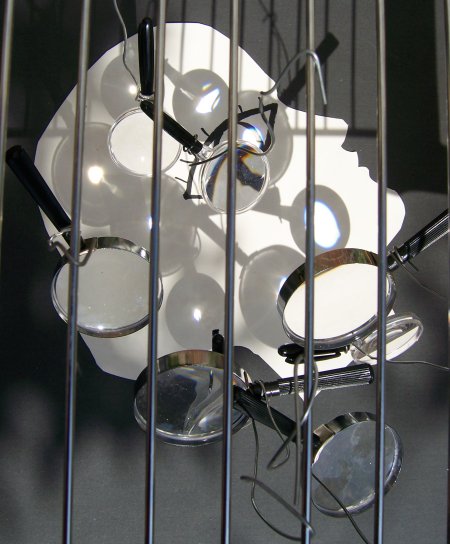Der richtige Fo kus


“sich kreuzende Blicke”
What may look at a first glance like as a cruel persistence of vision experiment or like an odd way to take photographs is a comment on the different properties of materials. The above experiment is the opposite of a shadow play (e.g. here or here) in that it uses a “sculpture” of magnifying glasses for collecting light in order to burn an eye-shaped imprint on a paper. (more images after the text)
There are two main approaches to make use of solar energy, namely firstly socalled solar thermal methods, which basically use the “heat” of the sun (like for boiling water) and secondly photovoltaics, which uses semiconductors (solar cells) for converting solar radiation into electric energy. In both approaches there are applications which use the same above principle of collecting light. In photovoltaics this is commonly called Concentrator Photovoltaics (CPV). Here lenses are collimating light rays in order to avoid the waste of expensive solar cell material and to provide more efficiency. Expensive materials are usually III-V compounds in particular Gallium arsenide, which is mostly used for space solar panels and not in consumer photovoltaics. Complex layered structures of gallium arsenide in combination with e.g. aluminium arsenide (AlAs) are very efficient , however gallium arsenide seems to be a hazardous substance, so research with layered (quantum dot) structures and concentrator technology is also made with silicon as a material, which is basically what sand is off.
Interestingly most of the solar cell research is done with experiments. This is on one hand because the theory (which is from the fifties) for e.g (crystalline) silicon semiconductors had been already implemented in computer modelling programs. The math behind it is very loosely speaking: Bloch’s theorem (which uses discrete symmetries) in order to account for the band structure of a semiconductor and Maxwells equations in order to describe the diffusion of electrons. However on the other hand even if apparently -as I learned- amorphous silicon solar cells (!)- are modelled with this software: things can get much more complicated if the involved sizes and symmetries are leaving the silicon crystal scheme. This e.g. happenes if one enters mesoscopic physics (e.g. here) were the math – which is needed for modelling and understanding nanostructures – can get very difficult.

